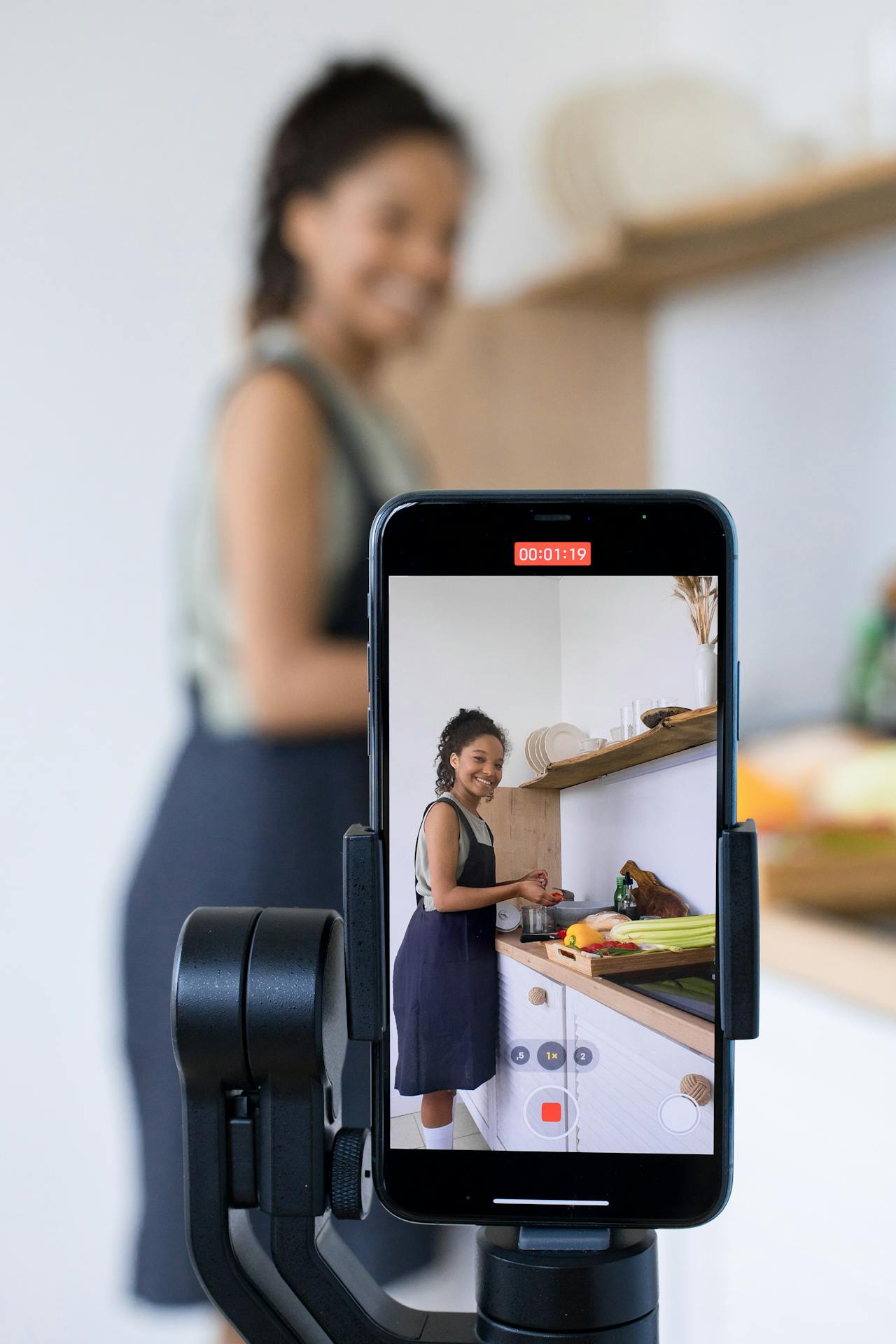Social media advertising isn’t everyone’s cup of tea.
It’s an expensive route to growing your business on social platforms. It requires intensive experimentation which costs a lot. Most businesses don’t have the resources to spend heaps of money on social media ads.
Organic social media reach, on the other hand, is a free and natural way to grow your brand on social sites.
It is a time-consuming process that requires consistency and patience.
Most importantly, organic reach is risk-free.
This article explores the 10 best practices and techniques for organic social media reach to grow your business. These tips are free and don’t require intensive resources, making them ideal for small businesses.
Let’s start from the basics…
What is Organic Social Media Reach?
Organic reach on social media refers to the reach of your content without ads or any other form of paid promotion. It is the natural growth and reach of social media content that you publish.
The social platform uses algorithms and machine learning to naturally promote your content and show it to people who are more likely to interact with your business or profile. Social networks use numerous factors to figure out what content to show people. These factors aren’t known publicly.
There are quite a few differences between organic and paid social media reach:
- Organic growth is slow, while paid reach is instant
- You can’t control organic reach whereas paid growth is fully controllable and manageable
- Organic reach relies on social media algorithms whereas paid reach doesn’t rely on algorithms for its reach and targeting
- Organic reach is considered more trustworthy by your target audience as opposed to paid ads that aren’t appreciated a lot
- You don’t have to control and manage anything with organic reach, it’s all natural. Paid reach requires management where you create, run, and manage ads
- Organic reach is free whereas paid growth costs you money.
The outcome in both cases is usually the same:
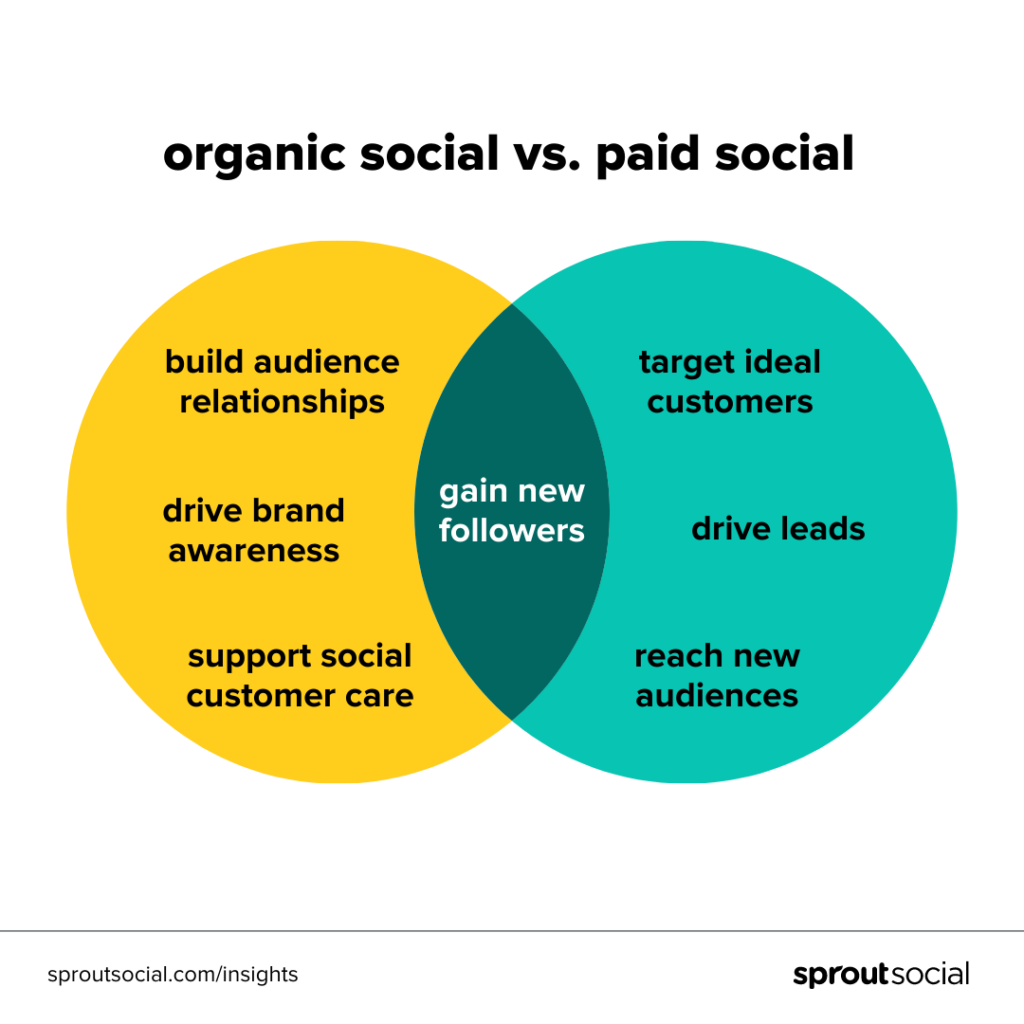
Since organic reach is free and trustworthy, it is a preferred choice of most businesses.
The only downside is its slow, natural outcome – and you can’t expedite it.
10 Tips to Increase Organic Social Media Reach
You can use proven techniques and strategies to boost the organic reach of your social content. Here’s a list of the best practices and tips you should incorporate in your social media marketing strategy for massive organic social media reach:
Create an Organic Social Media Strategy
Having a social media strategy isn’t enough, you need to have a formal strategy for organic social media growth. It should be embedded within your social media marketing strategy.
Most businesses design their social media strategy with a focus on paid marketing campaigns. They don’t have an action plan for organic reach and growth.
And this is a big mistake.
Develop an organic social media strategy for your business as the first step. Here’s what your strategy should include:
- Define the goal of your organic social media strategy. It should explain what you want to achieve with organic growth
- Set campaigns and an action plan to achieve organic growth
- Create a content strategy with an editorial calendar for social media
- Set up tracking and analytics to measure organic reach and growth.
Choose the Right Platforms
Not all social networks perform equally well.
This is for two main reasons:
- The target audience of each social network is different. For instance, Gen Zers use YouTube, TikTok, and Snapchat more than any other generation. If your primary target audience includes Baby Boomers, it’ll be a bad idea to invest in these platforms.
- There must be the top 1-2 social media platforms that your primary target audience uses the most. These networks should be your priority when trying to grow organic reach.

You need to use analytics to find out the best performing social media channel and then use it for organic reach. This will make it easier for you to grow organically on a platform that is already doing well (instead of using a new social platform).
Don’t use statistics and trends to identify social media channels for organic reach, as they might not always do well.
For instance, Facebook is the most used social platform in the world. Does this mean you should use Facebook to reach your audience organically?
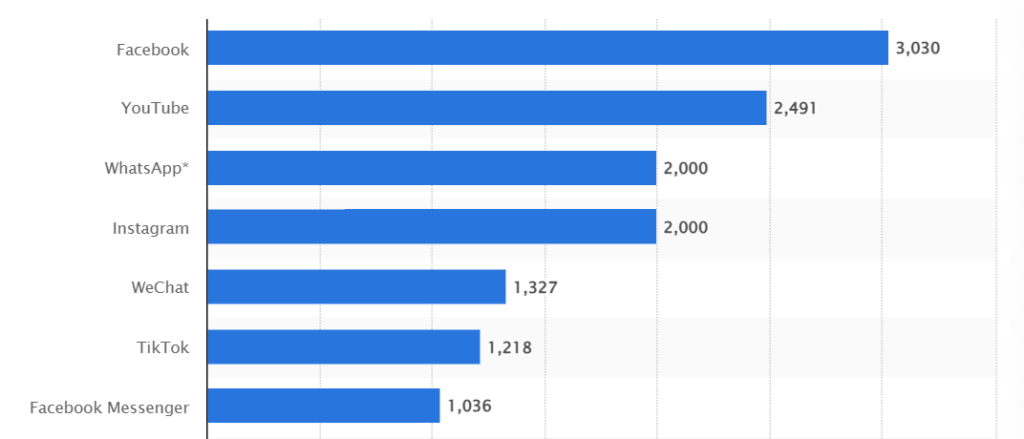
No.
Instead, you need to figure out what social media channel your audience uses. Use analytics, data, and buyer personas to choose the social networks that have done well in the past.
Publish Fresh Content Regularly
The more content you publish on social media, the better it is for reach and engagement.
Research shows that the industry average is around 11x per day:
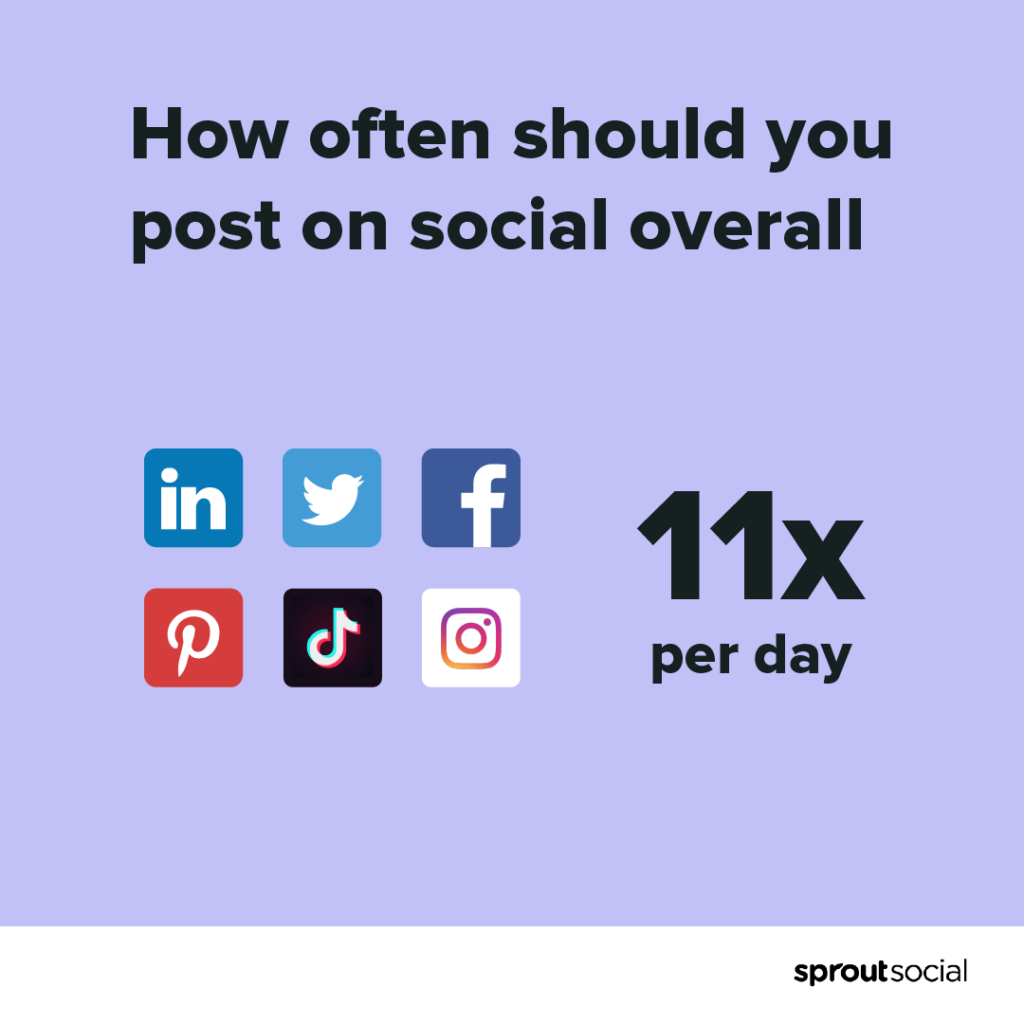
This isn’t, however, consistent. Facebook and X tend to get new content more often than video-based platforms (like TikTok and Instagram). This is because text-based social content is much easier to create.
Business posts 50x per month on X, 47x per month on Facebook, and 15x per month on TikTok:
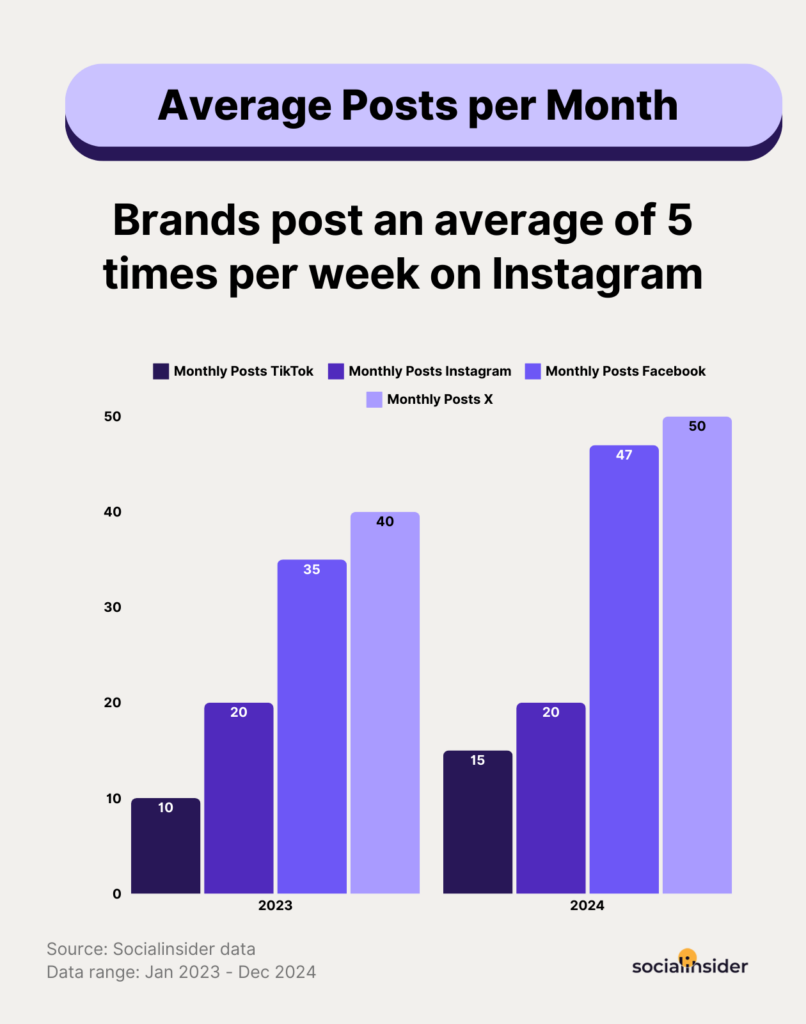
Research shows that pages having more than 10K followers see the highest engagement when they publish 31-60 times per month.
Organic social media reach depends on the frequency of new content you publish.
Here’s how:
- It helps the algorithm better understand your account and the type of content you publish
- Your target audience is more likely to see your content in their feed more often
- It boosts brand awareness, authority, and trust
- Your followers are more likely to engage with your content if they see new content from you every time they visit their feed.
Here are data-driven insights on the optimal publishing frequency for top social media platforms:
- Facebook: 2-15 posts per week
- X: 11 posts per week
- Instagram: 2-3 posts per week
- LinkedIn: 2-11 posts per week
- TikTok: 1-4 posts per day
- YouTube: 1 video per week
- YouTube Shorts: 1-3 videos per week.
The reach of your new content doesn’t just depend on the quantity, but quality also plays a key role. Don’t ruin content quality for the sake of publishing more posts per day.
Your content should be high-quality, authentic, and worth sharing.
Post at the Right Time
You can’t just schedule new posts at random. You need to ensure that your new content goes live at the right time on every platform you are targeting.
Research shows that there are certain days of the week and times of the day when engagement is highest. For instance, posts published on Facebook on Tuesday at 9 am have the highest engagement:

Here’s a breakdown of the engagement rate on Facebook based on when content is published:
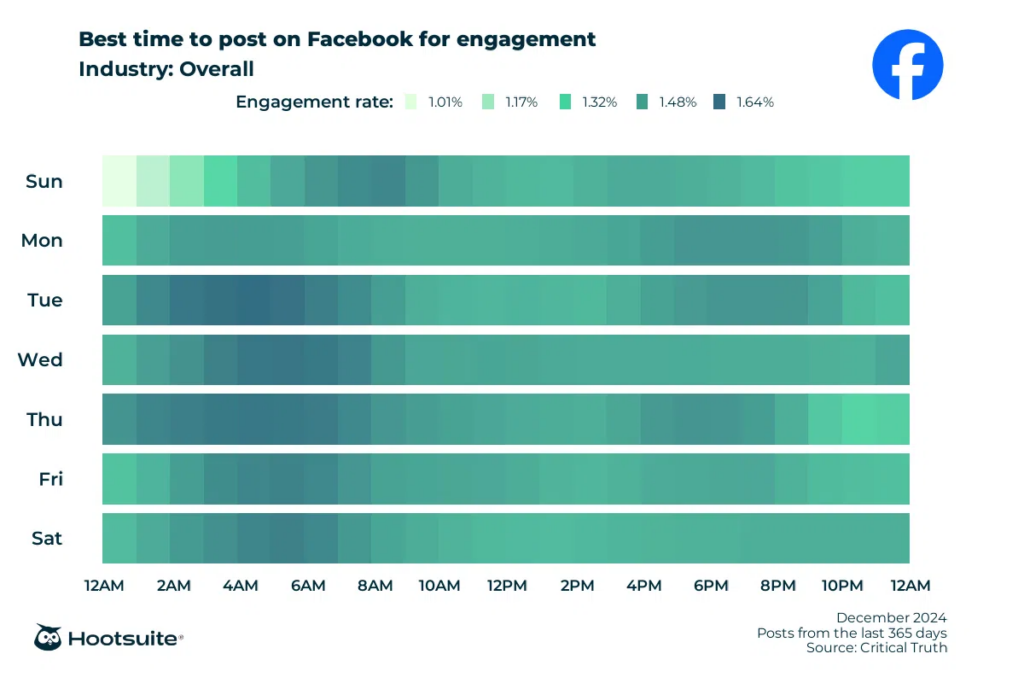
The same goes for every platform.
The day and time for the highest engagement are identified from analyzing thousands of accounts. These types of studies are published by social media marketing tools that have access to tons of user data.
This means you can trust these statistics.
Here’s an overview of the best times to publish content on different social media platforms based on 2025 data by Hootsuite:
- The best times to post content on Instagram are 3-9 pm on Monday, 5-8 am and 3-7 pm on Tuesday, and 5-7 pm on Thursday
- The best time to publish on Facebook is 9 am on Tuesday
- You should publish on X from 9-11 am on Wednesday, Thursday, and Friday to achieve the highest engagement
- The best time to post on LinkedIn for the highest engagement and reach is 4-6 am on Tuesday and Wednesday
- TikTok has the optimal time from 7-11 am on Thursday
- The ideal time to publish new content on Pinterest is 12 pm on Tuesday and Friday.
Ideally, you should schedule new posts at these times for maximum organic reach.
After some time, use analytics to figure out how these timings work for your business and audience. Tweak timings if any of these don’t suit you.
If you are new to social media marketing and need organic reach, you should definitely stick with these timings.
Create a Social Media Editorial Calendar
A social media editorial calendar is essential to boost organic social media reach because it helps you publish new content according to schedule.
It tells you when new content is to be posted, where it is to be published, who’ll create it, and other key details about social media content.
Here’s an example of a social media editorial calendar for Instagram:
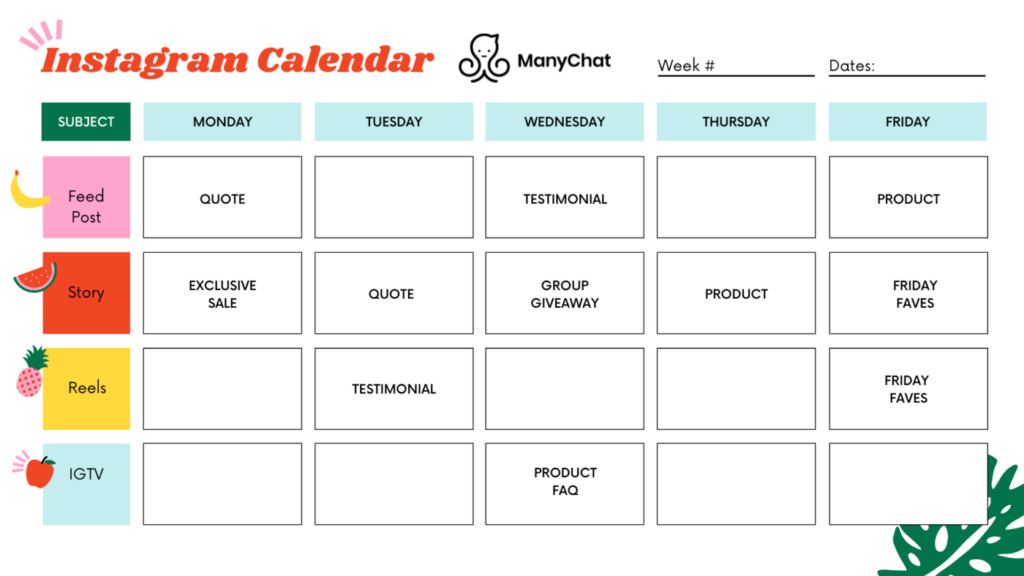
Instead of creating separate editorial calendars for different social platforms, you should create a single consolidated calendar, preferably in the scheduling app you use.
You can create a social media editorial calendar in multiple ways:
- Social media management platforms like Buffer, Hootsuite, Sprout Social, and others offer editorial calendars for the management of content.
- Meta Business Suite, for instance, also offers content Planner, where you can schedule posts for Facebook and Instagram from a single dashboard.

- You can use free editorial calendar templates like this one or this one. There are a lot of templates available online free of cost that you can download and use instantly.
- You can create your own template in Excel or Google Sheets, or Calendar. Add relevant details, assign tasks to relevant team members, and that’s it.
Here’s what your social media editorial calendar must have to be effective:
- It should be very detailed and must include all the information your team needs to create and publish social content
- The purpose of each post should be clearly defined so you know what it’s supposed to achieve
- Stick with your editorial calendar and ensure that you follow it strictly
- Have at least a week’s worth of content prepared in advance.
The purpose of using an editorial calendar is to publish quality content across social media channels to boost reach and engagement. Make sure your calendar achieves this purpose.
Post Evergreen Content
Evergreen content refers to any content type (in any format) that stays relevant for an extended period of time. This content type has no expiration date and stays on trend for years to come.
Here’s an example of evergreen content:

Evergreen content is best for boosting the organic reach of your social content because it stays relevant and people continue to interact with it for years to come.
Seasonal content, on the other hand, such as news and content based around recent trends, has a limited life. People lose interest in them after a few days, and the algorithm stops showing this type of content in feeds (due to a decline in interest).
A major portion of the weekly social posts you publish should consist of evergreen content. Here are the key characteristics of evergreen content that you should look for when identifying topics for a social media editorial calendar:
- Timelessness is a major characteristic of evergreen content. It includes topics that are free from events and time. For instance, how-to guides are evergreen content that always stay relevant and people don’t lose their interest.
- Evergreen content covers broad topics (instead of niche topics) that appeal to a wide range of people. Content with a limited audience or content that interests a specific group might not be a good option to qualify as evergreen content. The idea of using evergreen content in social posts is to ensure that it attracts a general audience for years.
- Consistent value is another characteristic of evergreen content which means it offers the same value to your audience irrespective of when they interact with it. The value doesn’t decline and it stays fresh forever.
Your editorial calendar should have a mix of evergreen and trending content because both are required for organic growth. However, a major portion (approximately 80%) of social content should be evergreen as that’s what matters the most for organic reach.
Optimize Your Social Accounts and Profiles
Your social media profile plays a crucial role in organic reach. Algorithms need to understand your profile and account so they can recommend your content to the right people who are more likely to interact with your content and profile.
If the algorithm can’t understand what your account is about, what your business is, and what type of audience you are targeting – you’ll see a decline in organic reach.
The idea is to make it easy for social algorithms (and your target audience) to better understand who you are and what you do. That’s a sure way to significantly improve organic social media reach.
Here’s an example of how X algorithm recommends relevant accounts to people based on the type of content they have engaged with recently:

This works for all the social media platforms as they use somewhat similar algorithms.
How to optimize social profiles and accounts?
Follow these guidelines and best practices for social profile and account optimization across all social networking sites:
- Choose a short, memorable, and relevant username. It should be relevant to your business, preferably your business name
- Add a professional profile and cover photo. Instead of using random images, add images that are relevant to your business and must communicate with your audience
- Add description or bio with relevant keywords and a powerful CTA. This is where you need to add all the relevant details for algorithms and potential followers so they can know what your brand is all about
- Your profile should have links to your website, phone number, business address, CTA, and links to other sources (such as other social media profiles, landing page, lead magnets, etc.)
- Complete your profile by adding all the details of all types. Don’t skip anything. Avoid adding filler information. There’s a reason social networks ask all those details
- Optimize your account by pinning the most important post at the top so that it’s instantly visible to people who visit your profile for the first time
- Publish all types of content in all formats to your account
- Optimize images and videos you publish and ensure they are in the right dimension for the platform being published to.
Engage with Followers
Research shows that 64% of people want brands to connect with them actively on social media and 55% of people say that they want brands to like or respond to consumers on social media:

You can engage with your followers in multiple ways on social media:
- Respond to comments and questions appropriately
- Avoid using canned or template responses
- Publish interactive content such as quizzes and polls that allow your followers to interact with your brand
- Tag people when addressing them so they get notified and respond
- Create conversational content at least once per week to boost engagement
- Ask your followers to comment, like, and share your content. Asking doesn’t hurt.
When you perform any of these engagement activities, you create a positive brand image in two major ways:
- Responding to followers and engaging with them shows your concern and the positive experience your brand creates for its audience
- When new, unknown people see your positive engagement, they are more likely to convert into customers or followers.
High engagement leads to massive organic reach as algorithms favor engaging content and profiles that are more likely to hook their audience.
Leverage Hashtags
Some social networking platforms like Instagram, X, and TikTok use hashtags that make it easy for you to reach the right people. Hashtags boost engagement which leads to higher reach on social media:
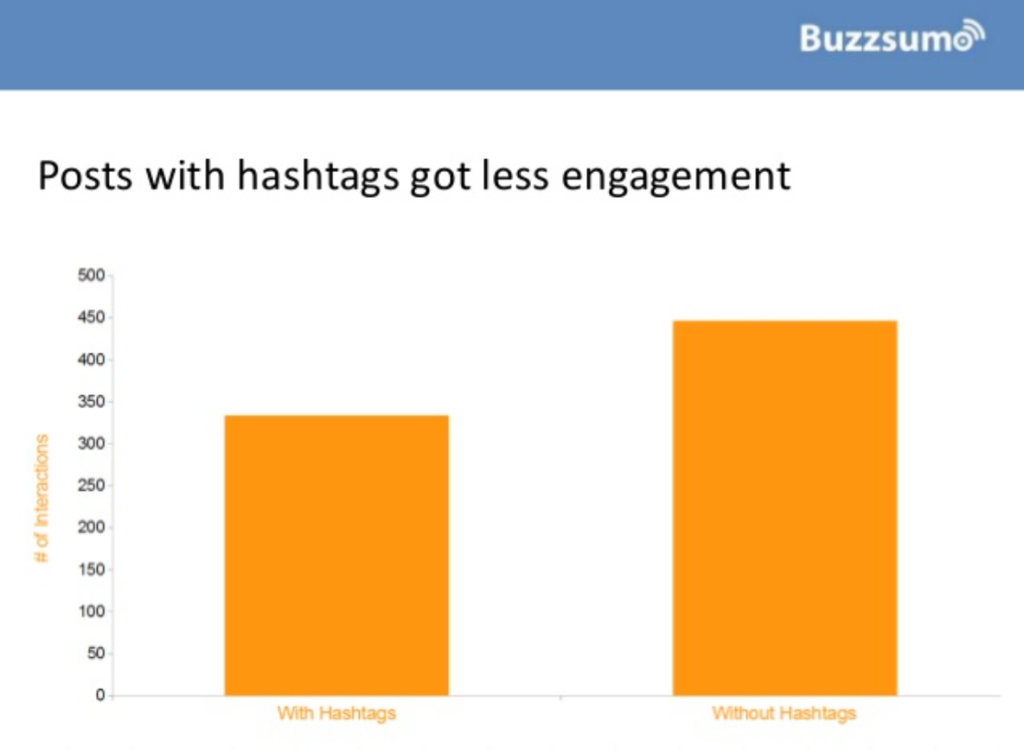
Social networking sites use hashtags for categorization and visibility. If you incorporate the right hashtags in your posts, you can significantly boost organic reach as it boosts your content’s visibility.
You don’t have to use any random hashtags, rather you need to analyze and track hashtags and then use the ones that people actively search for.
Follow these guidelines to use hashtags to boost organic social media reach:
- Find relevant, trending hashtags and add them to your posts
- Add 1-2 hashtags per post as they are proven to have the highest engagement
- Use a mix of trending and evergreen hashtags
- If you have a decent number of followers, consider creating your branded hashtag
- Use a social media listening tool like RiteTag to find the right hashtags for your content
- Use analytics to see how different hashtags perform and tweak your strategy accordingly.
Follow and Interact with Others
Interacting with others increases your organic social media reach in multiple ways.
First, when you follow or leave a comment on someone else’s post, you instantly reach their audience. You can do this to reach a wider audience in no time.
For instance, you can interact with posts of niche influencers who have highly engaged followers. This is a nice way to build connections and grow organically.
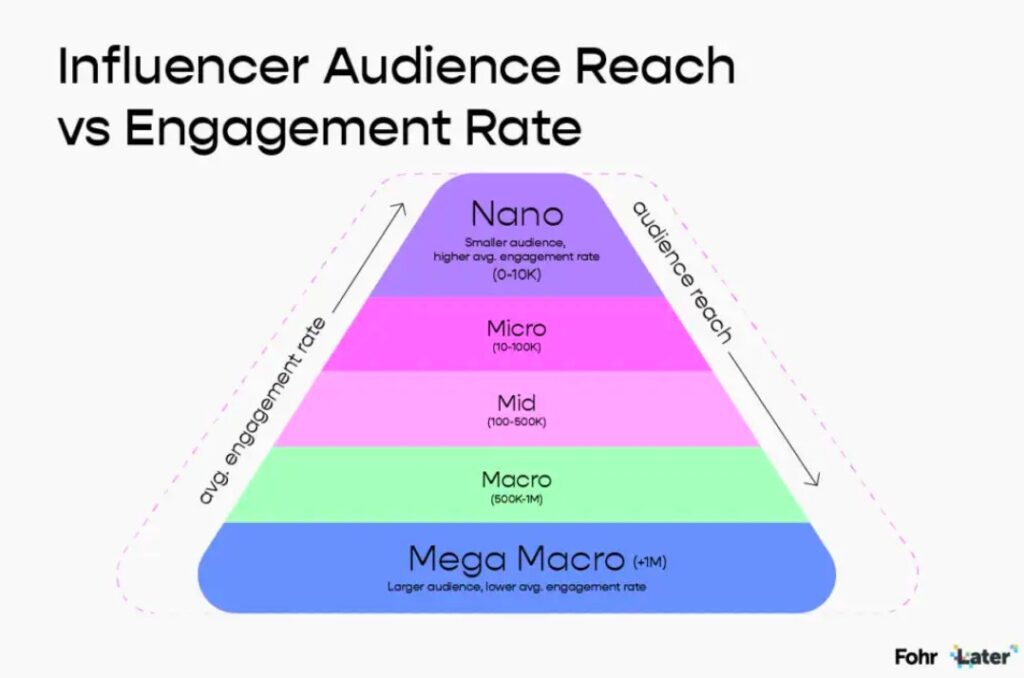
Second, algorithms start favoring your account and content as they get to know your interests better. People and accounts who don’t interact with others don’t generate data and it gets hard for algorithm to understand them and therefore, it can’t recommend their content and profile to relevant people.
The more you interact with others and share and like content, the easier it gets for algorithms to understand your brand and account.
Consequently, it starts promoting your account and content organically to boost engagement.
Algorithms of social media accounts always favor content and people who are more likely to drive engagement as that’s how their social network works and earns.
Third, interacting with others creates a positive brand image. Your target audience sees your comments, likes, shares, and people you follow – and this tells them that your business isn’t all about itself.
Research shows that 37% of people say that brands that prioritize engagement with their audience are most memorable on social media and 28% say that brands that highlight the stories of their audience over their products are the most memorable ones:

In simple words, you need to engage with your followers and share their content. This creates a positive brand image and you boost organic reach.
Here are a few best practices to boost interaction for massive social media organic reach:
- Follow back your followers
- Follow influencers and others who post similar content
- Like, comment, and share content of your followers, audience, and others
- Share UGC content
- Be open and transparent
- Don’t over-promote your products, rather keep it natural and informative.
Final Thoughts
Organic social media reach isn’t a one-off task.
It requires consistency, planning, and constant tweaking of your strategy.
Most importantly, it requires patience. You might not see results instantly as you see with paid ads on social media.
Organic reach is time-consuming and the impact might not be as massive as social ads initially. But once it starts rolling, you’ll never run ads again.
The 10 tips and best practices shared above will help you set the stage for organic reach for your business. Then, you need to use analytics and data to tweak your campaigns and strategy for improvement.
Optimization is essential for social media organic reach.
Featured Image: Pexels


